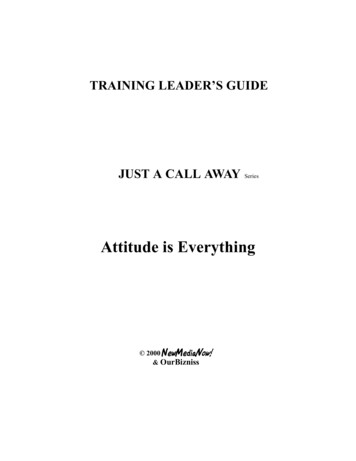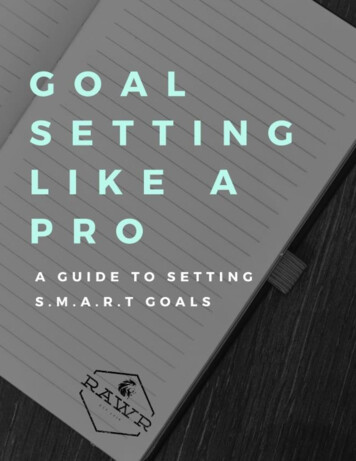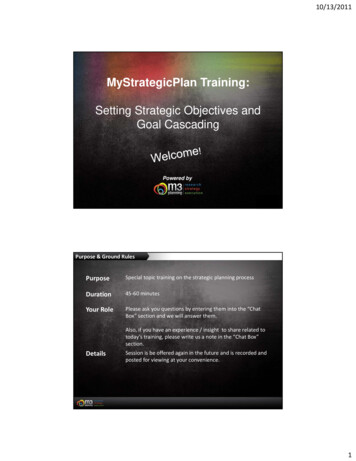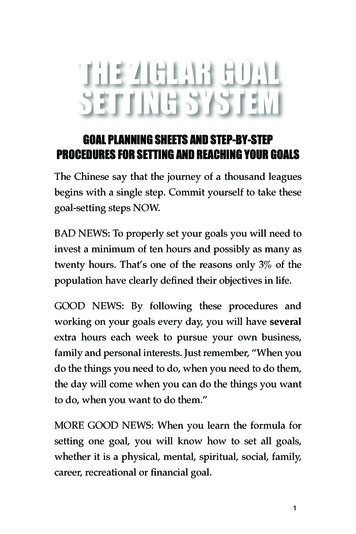
Transcription
1Attitude, Goal Setting,and Life Managementfuture dreams happinessAfter studying these topics, you will benefit by: Discovering the influence professionalism and positive human relations have on personal,academic, and career successKnowing how individual personality, attitude, and values affect the workplaceRecognizing how self-efficacy and personal branding affect your confidenceDeveloping a strategy to deal with past negative experiences and other barriers to successExamining the impact goal setting has on creating a life plan in today’s economyChoosing priorities to support your goals Copyright 2016, 2013, 2011 by Pearson Education, Inc.How Do You Rate?Are you self-centered?1.Do you rarely use the word I in conversations?2.When in line with coworkers, do you let coworkers go ahead of you?3.Do you keep personal work accomplishments private?4.Do you rarely interrupt conversations?5.Do you celebrate special events (e.g., birthdays, holidays) with yourcoworkers by sending them a card, a note, or small gift?YesNoIf you answered “yes” to two or more of these questions, well done. Your actions are more focusedon the needs of others and you are most likely not self-centered.M01 ANDE9447 04 SE C01.indd 106/11/14 6:25 PM
2Chapter 1 Attitude, Goal Setting, and Life ManagementAll About YouCongratulations! You are about to embark on a self-discovery to identify how tobecome and remain productive and successful in the workplace. The first step inthis self-discovery is to perform a simple exercise. Look in a mirror and identifythe first three words that immediately come to mind.These three words are your mirror words. Mirror words describe how youview yourself and how you believe others view you. Your perception of yourselfinfluences your relationship with coworkers and your workplace performance.This text is all about professionalism in the workplace. The goal of bothyour instructor and the authors is to not only assist you in securing the jobof your dreams, but to keep that great job and advance your career based onhealthy, quality, and productive work habits that benefit you, your coworkers,and your organization. Professionalism is defined as workplace behaviors thatresult in positive business relationships. This text provides you tools to helpyou experience a more fulfilling and productive career. The secret to healthyrelationships at work is to first understand yourself. Once you understand yourpersonal needs, motivators, and irritants, it becomes easier to understand andsuccessfully work with others. This is why the first part of this chapter focuseson your personality, your values, and your self-concept.An individual’s personality and attitude dictate how he or she respondsto conflict, crisis, and other typical workplace situations. Each of these typicalworkplace situations involves working with and through people. Understanding your own personality and attitude makes it much easier to understand yourreaction to others’ personalities and attitudes.Human relations are the interactions that occur with and through people.These interactions create relationships. Therefore, you theoretically have relationships with everyone you come into contact with at work. For an organization to be profitable, its employees must be productive. It is difficult to beproductive if you cannot work with your colleagues, bosses, vendors, and/orcustomers. Workplace productivity is a result of positive workplace interactionsand relationships.Personality is a result of influences, and there are many outside influencesthat affect workplace relationships. These influences may include immediatefamily, friends, extended family, religious affiliation, and even society as a whole.Conversely, experiences and influences at work affect your personal life. Therefore, to understand workplace relationships, you must first understand yourself.Personality and ValuesBehavior is a reflection of personality. Personality is a stable set of traits thatassist in explaining and predicting an individual’s behavior. Personality traits canbe positive, such as being caring, considerate, organized, enthusiastic, or reliable.However, personality traits can also be negative, such as being rude, unfocused,lazy, or immature. For example, if you are typically organized at work and suddenly you become disorganized, others may believe something is wrong becauseyour disorganized behavior is not in sync with your stable set of organized traits.An individual’s personality is shaped by many variables, including past experience, family, friends, religion, and societal influences. Perhaps a family memberM01 ANDE9447 04 SE C01.indd 206/11/14 6:25 PM
3Chapter 1 Attitude, Goal Setting, and Life Managementwas incredibly organized and passed this trait on to you. Maybe someone in yoursphere of influence was incredibly disorganized, which influenced you to be veryorganized. These experiences (positive or not) shape your values. Values arethings that are important to you as an individual based on your personal experiences and influences. These influences include religion, family, and societalissues such as sexual preference, political affiliation, and materialism. Note thatyou may have good or bad values. You may value achievement, family, money,security, or freedom. For example, one individual may not value money becausehe or she has been told that “money is the root of all evil.” Contrast this with anindividual who values money because he or she has been taught that money is avaluable resource used to ensure a safe, secure future. Because values are thingsthat are important to you, they will directly affect your personality. If you havebeen taught that money is a valuable resource, you may be very careful in yourspending. Your personality trait will be that of a diligent, hardworking personwho spends cautiously. A more in-depth discussion of values and how they relateto business ethics is presented in Chapter 5.Topic SituationWhile in school, Charley worked hard to secure a new job as an assistant at hiscollege bookstore. Charley’s parents are both college graduates with successfulcareers, which influences Charley’s values and beliefs in the ability to performsuccessfully at school and work. However, many of Charley’s friends are notattending college, and have a hard time securing and/or maintaining employment. For this reason, Charley gets no support from these friends regardingearning a degree and holding a job.Topic ResponseIf Charley continues to associate with his non-supportivefriends, how could thesefriendships influence Charley’s performance at schooland work?Copyright 2016, 2013, 2011 by Pearson Education, Inc.AttitudeAn attitude is a strong belief about people, things, and situations. For example, youeither care or do not care how your classmates feel about you. Your attitude is relatedto your values and personality and affected by past success and failures. Using theprevious example, if you value money, your attitude will be positive toward workbecause you value what you get in return for your work effort—a paycheck. Attitudeaffects performance: An individual’s performance significantly influences a group’sperformance, and a group’s performance, in turn, affects an organization’s performance. Think about a barrel of juicy red apples. Place one bad apple in the barrelof good apples, and, over time, the entire barrel will be spoiled. That is why it is soimportant to evaluate personal influences. The barrel reflects your personal goalsand your workplace behavior. Your attitude affects not only your performance, butalso the performance of those with whom you come in contact.Does this mean you avoid anyone you believe is a bad influence? Not necessarily. You cannot avoid certain individuals, such as relatives and coworkers. However, you should be aware of the impact individuals have on your life. If certainindividuals have a negative influence, avoid or limit your exposure to them (badapple). If you continue to expose yourself to negative influences, you can losesight of your goals, which may result in a poor attitude and poor performance.Choose your friendships wisely and surround yourself with positive people. Positive people are truthful, faithful, loving, and supportive. Negative people interferewith you reaching your goals by making you uncomfortable or by distracting you.M01 ANDE9447 04 SE C01.indd 3Think About ItIdentify one friend that youbelieve is a positive influence on you and a friendthat is a negative influence.How should you handlethese relationships?06/11/14 6:25 PM
4Chapter 1 Attitude, Goal Setting, and Life ManagementTalk It OutWhat cartoon characterbest reflects your personality and why?Self-Efficacy and Its InfluencesReview your “mirror words” from the beginning of this chapter. Were yourwords positive or negative? Whatever you are feeling is a result of your selfconcept. Self-concept is how you view yourself. Thinking you are intelligentor believing you are attractive are examples of self-concept. Self-image is yourbelief of how others view you. If your self-concept is positive and strong, youwill display confidence and not worry about how others view you and youractions. If you are insecure, you will rely heavily on what others think of you.Although it is important to show concern for what others think of you, it ismore important to have a positive self-concept. Note that there is a differencebetween being conceited and self-confident. Those who behave in a conceitedmanner have too high an opinion of themselves as compared to others. Peopleare drawn to individuals who are humble, display a good attitude, are confident, and are consistently positive. It is easy to see the tremendous impactboth personality and attitude have in the development of your self-esteem andself-concept. One final factor that influences self-concept and performanceis that of self-efficacy. Self-efficacy is your belief in your ability to perform atask. For example, if you are confident in your math abilities, you will mostlikely score high on a math exam because you believe you are strong in thatsubject. However, if you are required to take a math placement exam for a joband are not confident in your math abilities, you will most likely not performwell. The way you feel about yourself and your environment is reflected inhow you treat others. This is called projection. A positive self-concept will beprojected toward others.Envision a hand mirror. The handle of the mirror (the foundation) is yourpersonality. The frame of the mirror represents your personal values. The mirroritself is your attitude, which is reflected for you and the world to see. The wayyou view yourself is your self-concept; the way you believe others see you is yourself-image. As you begin networking with others, interviewing for a new job, orembarking on a new career, create a personal brand. A personal brand reflectstraits you want others to think of when they think of you. These personal traitsmay include your appearance, your values, or specific knowledge or skills thatmake you unique, interesting, and of value to others. Throughout this text, youwill be gaining additional tools designed to improve your professionalism. Usethese tools to refine your personal brand and make a commitment to continueenhancing your brand. Doing so will contribute to a positive self-concept andincrease your odds for both personal and professional success.Exercise 1.1Define your personal brand. Identify desired appearance, personality, knowledge and skills, personalvalues, and attitude.M01 ANDE9447 04 SE C01.indd 406/11/14 6:25 PM
5Chapter 1 Attitude, Goal Setting, and Life ManagementDealing with Negative BaggageMany of us have experienced people who appear to have a chip on their shoulder that negatively influences their behavior. The negativity is reflected in anindividual’s personality. More often than not, the “chip” is a reflection of a painful past experience. What many do not realize is that negative past experiencessometimes turn into personal baggage that creates barriers to career success.Examples of negative past experiences may include traumatic issues such as anunplanned pregnancy or a criminal offense. Other times, the negative experienceinvolved a poor choice or a failure at something that had great meaning. Theseexperiences are the ones that most heavily influence one’s personality, values,and self-concept, and in turn, may affect workplace attitude and performance.Topic SituationWhen starting high school, Keira made a poor choice and got in minor troublewith the law. Keira paid her dues, yet is still embarrassed and sometimes feelsunworthy of a successful future. Keira is trying to climb the mountain of successcarrying a hundred-pound suitcase. The suitcase is filled with the thoughts of aprevious poor choice and embarrassment. Because of Keira’s motivation to complete college, most friends and acquaintances are unaware of her past mistake.However, if Keira continues to carry this negative baggage, she may lose sightof her goals.Topic ResponseWhat steps should Keiratake to help her achieve hergoals?Copyright 2016, 2013, 2011 by Pearson Education, Inc.If you have had a negative experience that is hindering your ability to succeed, recognize the impact your past has on your future. Although you cannotchange yesterday, you can most certainly improve your today and your future.Take these steps toward a more productive future:1. Confront your past. Whatever skeleton is in your past, admit that thenegative event occurred. Do not try to hide or deny that it happened.There is no need to share the episode with everyone, but it may helpto confidentially share the experience with someone you trust (friendor trained professional) who had no involvement with the negativeexperience. Acknowledgement of the negative event is the first steptoward healing.2. Practice forgiveness. Past negative experiences hurt. A process in healingis to forgive whoever hurt you. Forgiveness does not justify that whatoccurred was acceptable, but reconciles in your heart that you are dealing with the experience and are beginning to heal. Identify who needsforgiveness. The act of forgiveness may involve a conversation with someone, or it may just involve you deciding to no longer carry this burden.3. Move forward. Let go of hurt, guilt, and/or embarrassment. Do not keepdwelling on the past and using it as an excuse or barrier toward achieving your goals. If you are caught in this step, physically write the experience down on a piece of paper and the words “I forgive Joe” (replacethe name with the individual who harmed you). Then take the paperand destroy it. This physical act puts you in control and allows youto visualize the negative experience being diminished. As you becomemore confident in yourself, your negative experience becomes enveloped with the rest of your past and frees you to create a positive future.M01 ANDE9447 04 SE C01.indd 506/11/14 6:25 PM
6Chapter 1 Attitude, Goal Setting, and Life ManagementThis sometimes painful process is necessary if your goal is to become thebest individual you can be. Dealing with negative baggage is not something thathappens overnight. As mentioned previously, some individuals may need professional assistance to help them through the process. There is no shame in seekinghelp. In fact, there is great freedom when you have finally let go of the baggageand are able to climb to the top of the mountain unencumbered.Locus of ControlThe reality is that you will not always be surrounded by positive influences andyou cannot control everything that happens in your life. Your attitude is affectedby who you believe has control over situations that occur in your life, both personally and professionally. The locus of control identifies who you believe controls your future. An individual with an internal locus of control believes thathe or she controls his or her own future. An individual with an external locus ofcontrol believes that others control his or her future.Extremes on either end of the locus of control are not healthy. Realize thatindividual effort and a belief in the ability to perform well translate to individualsuccess. External factors also influence your ability to achieve personal goals. Youcannot totally control the environment and future. Power, politics, and other factors discussed later in the text play an important part in the attainment of goals.Successful individuals take personal responsibility and avoid blaming others.Learning StylesAnother element of personality is one’s learning style. Learning styles definethe method of how you best take in information and/or learn new ideas. Thereare three primary learning styles: visual, auditory, and tactile/kinesthetic.To determine what your dominant learning style is, perform this simpleexercise. Imagine you are lost and need directions. Do you:a.b.c.Want to see a mapWant someone to tell you the directionsWant to draw or write down the directions yourselfIf you prefer answer a, you are a visual learner. You prefer learning by seeing.If you selected b, you are an auditory learner. You learn best by hearing. If youselected c, you are a tactile/kinesthetic learner, which means you learn best byfeeling, touching, or holding. No one learning style is better than the other.However, it is important to recognize your primary and secondary learning stylesso that you can get the most out of your world (in and out of the classroomor on the job). As a visual learner, you may digest material best by reading andresearching. Auditory learners pay close attention to course lectures and classdiscussions. Tactile/kinesthetic learners will learn best by performing application exercises and physically writing course notes. Recognize what works bestfor you and implement that method to maximize your learning experience. Alsorecognize that not everyone learns the same way you do and not all informationis presented in your preferred method. With that recognition, you can become abetter classmate, team member, coworker, and boss.M01 ANDE9447 04 SE C01.indd 606/11/14 6:25 PM
7Chapter 1 Attitude, Goal Setting, and Life ManagementExercise 1.2Apply the learning styles discussed and complete the following statements.In the classroom, I learn best byIn the classroom, I have difficulty learning whenHow will I use this information to perform better?Importance and Influences of Personal Goal SettingEveryone has dreams. These dreams may be for a college degree, a better life forloved ones, financial security, or the acquisition of material items such as a newcar or home. Goal setting is the first step toward turning a dream into a reality.This important process provides focus and identifies specific steps that needto be accomplished. It is also a common practice used by successful individualsand organizations. A goal is a target. Think of a goal as a reward at the top ofa ladder. To reach a goal, you need to progress up each step of the ladder. Eachstep contributes to the achievement of a goal and supports your personal values.Goals help you decide what you want in your future, increase self-concept, andhelp overcome procrastination, fear, and failure.When you set goals, career plans become more clear and meaningful. Theymotivate you to continue working to improve yourself and help you achieve—notjust hope for—what you want in life.Copyright 2016, 2013, 2011 by Pearson Education, Inc.Topic SituationAt 22 years of age, Austin had only a high-school education. After working oddjobs at minimum wage since graduating from high school, Austin decided toattend college to become a Certified Public Accountant (CPA). Austin set a longterm goal to finish college in five years. Self-supporting and having to work, heset a realistic goal to obtain an associate degree in accounting within three years.After achieving that goal, Austin plans to find a job as an account clerk whilefinishing school. This goal will increase his income and self-confidence. Still committed to becoming a CPA, he plans to earn a bachelor’s degree in accountingwithin two years after receiving the associate degree.Goals can and should be set in all major areas of your life, including personal, career, financial, educational, and physical. Goals help maintain a positiveoutlook. They also contribute to creating a more positive perception of yourselfand result in improved human relations with others.Example of Austin’s goals:Five-year long-term goalObtain a bachelor’s degree in accountingThree-year long-term goalObtain an associate degree in accounting and securea job as an account clerkOne-year short-term goalSuccessfully pass the appropriate courses toward theassociate degree and identify an internshipNowApply for school and find a part-time job to obtainwork experienceM01 ANDE9447 04 SE C01.indd 7Topic ResponseWhat are specific stepsAustin can take to ensure hereaches his goal of becominga CPA?Talk It OutShare one goal you haveset for this class.06/11/14 6:25 PM
8Chapter 1 Attitude, Goal Setting, and Life ManagementHow to Set GoalsAs explained earlier, achieving goals is like climbing a ladder. Imagine that thereis a major prize (what you value most) at the top of the ladder. The prize canbe considered your long-term goal, and each step on the ladder is a progressiveshort-term goal that helps you reach the major prize.Set short-term and long-term goals and put them in writing. Long-termgoals are goals that take longer than a year to accomplish, with a realistic window of up to 10 years.To set a goal, first identify what you want to accomplish in life. Writedown everything you can think of, including personal, career, and educational dreams. Next, review the list and choose which items you most value.In reviewing your list, ask yourself where you want to be in one year, fiveyears, and 10 years. The items you identified are your long-term goals.Keep each goal realistic and something you truly want. Each goal should beattainable, yet challenging enough to work toward. Identify why each goal isimportant to you. This is a key step toward setting yourself up for success.Next, identify opportunities and potential barriers toward reaching thesegoals. Remember Austin’s goal to be a CPA? Austin believes becoming a CPArepresents success. It is important to him, and it is a realistic goal that canbe reached.Exercise 1.3Identify educational, personal, and professional accomplishments you would like to achieve in 5–10years.Short-term goals are goals that can be reached within a year’s time. Theyare commonly set to help reach long-term goals. Businesses often refer to shortterm goals as objectives because they are measurable and have a one year or lesstime line. Short-term goals can be achieved in one day, a week, a month, or evenseveral months. As short-term goals are met, long-term goals should be updated.Just like long-term goals, short-term goals (objectives) must be realistic, achievable, and important to you. They need to be measurable so you know when youhave actually reached them.An additional long-term goal for Austin is to buy a car one year after graduation. Austin has set several short-term goals, one being to save a specific amountof money each month. To do this, he needs to work a certain number of hourseach week. He also needs to be specific about the type of car, whether to buy usedor new, and whether he needs to take out a loan. The answers to these questionswill determine how much money Austin will need to save each month and if theone-year time frame is realistic.M01 ANDE9447 04 SE C01.indd 806/11/14 6:25 PM
Chapter 1 Attitude, Goal Setting, and Life Management9Exercise 1-4Using the goals you identified in Exercise 1.3, identify how you can turn each dream into a reality.A popular and easy goal-setting tool is the SMART method. SMART is anacronym for writing goals to ensure they are specific, measurable, achievable,relevant, and time based.Copyright 2016, 2013, 2011 by Pearson Education, Inc.ExampleSSpecificClearly identify what exactly youwant to accomplish and, if possible, make your goal quantifiable.This makes your goal specific.Become a manager for atop accounting firmMMeasurableMake your goal measurable. Identify how you will know when youhave achieved your goal.Having the job as amanagerAAchievableKeep your goal achievable but nottoo easily attainable or too farout of reach. A good achievablegoal is challenging, yet attainableand realistic.Getting good gradesin college and gainingwork experience alongthe wayRRelevantRelevant personal goals havemeaning to its owner. The goalshould belong to you, and youshould have (or have access to)the appropriate resources toaccomplish the goal.I want to do thisTTime BasedAttach a specific date or timeperiod to provide a time framefor achieving the goal.By 2021For example, instead of writing, “I will become a manager in the future,”write, “After attending college and getting work experience, I will become a manager with a top accounting firm by the beginning of the year 2021.” After youhave written a goal, give it the SMART test to increase its probability for success.After you have written positive and detailed goals, there are a few additionalaspects of goal setting to consider. These include owning and taking control ofyour goals.Owning the goal ensures that the goal belongs to you. You are the one whoshould decide your goals, not your parents, spouse, significant other, friends,relatives, or anyone else. For example, if Austin goes to college because it is hispersonal dream to be a CPA, that goal will be accomplished. However, if Austinbecomes a CPA because his parents want him to be a CPA, this will not be Austin’s goal and it will be harder to accomplish.M01 ANDE9447 04 SE C01.indd 906/11/14 6:25 PM
10Chapter 1 Attitude, Goal Setting, and Life ManagementTake control of your goal by securing information necessary to accomplishit. Know what resources and constraints are involved, including how you willuse resources and/or get around constraints. If your goal is related to a specificcareer, identify what is required to attain that career in regard to education,finances, and other matters. Clarify the time needed to reach your goals by writing them as short-term or long-term goals. Applying the concept of locus ofcontrol, remember that not every factor is within your control. Therefore, beflexible and realistic with your goals and the time you take to achieve them.Creating a Life PlanIdentifying goals contribute to the creation of a life plan. A life plan is a writtendocument that identifies goals for all areas of your life, including career, family/social, spiritual, and financial.Consider what you want in the following areas of your life: Education and career: Degree attainment, advanced degrees, respectablejob titles, specific employers Social and spiritual: Marriage, family, friends, religion Financial: Home ownership, car ownership, investments Activities: Travel, hobbies, life experiencesCreate goals for each of these major life areas and establish goals that reflectyour values. Note that some goals may blend into two or more areas. Rememberthat goals can change over time; stay focused but flexible.It is common for younger students to be uncertain of their career goals.Others may feel overwhelmed that they have a life goal but lack the necessaryresources to accomplish one or more goals. Education is an important key toachieving personal and career goals and no one can take your knowledge fromyou. When writing your life goals, consider the degrees/certificates, the timeframe, the financial resources, and the support network you will require for educational success. Make college course choices based on your desired educationalgoals. Choose courses that will benefit you, help you explore new concepts, andchallenge you. To be successful in your career, it is important to enjoy what youdo. Select a career that supports your short-term and long-term goals. Whenplanning your career consider: Why your target career is important to you What resources are needed to achieve your career goal How you will know you have achieved career successWeb SearchDiscover your personality:Take one of the personalityand career assessmentsavailable on MyStudentSuccessLab, or conduct aweb search to identify anonline quiz that will helpyou discover your personality and career interests.M01 ANDE9447 04 SE C01.indd 10People choose careers for different reasons, including earning power, status,intellect, values, and self-satisfaction. If there is a career center available at yourcollege, take time to visit and explore the various resources it offers. There arealso several personality and career interest tests that will help you determinecareer options. Career assessments are offered at many college career centers andonline. These useful assessments assist in identifying interests, abilities, and personality traits to determine which career will suit you best. Take advantage of allavailable resources and gather information to assist you in making the optimalcareer decision. Conduct an Internet search, perform an internship, volunteer,interview, or job shadow someone working in the field that interests you. Doingso will help clarify your goals and life plan. An additional discussion on careerexploration is presented in a later chapter.06/11/14 6:25 PM
Chapter 1 Attitude, Goal Setting, and Life ManagementConsider the type of personal relationships you want in the future. Goalsshould reflect your choice of marriage, family, friends, and religion. Identifywhere you want to be financially. Many people dream of becoming a millionaire, but you need to be realistic. Think about what kind of house you want tolive in and what type of car you want to drive. If a spouse and children are inyour future, account for their financial needs as well. Also identify what ou
2 Chapter 1 Attitude, Goal Setting, and Life Management All About You Congratulations! You are about to embark on a self-discovery to identify how to become and remain productive and successful in the workplace. The first step in this self-discovery is to










